Citroen C4 PICASSO RHD 2014.5 1.G User Guide
Manufacturer: CITROEN, Model Year: 2014.5, Model line: C4 PICASSO RHD, Model: Citroen C4 PICASSO RHD 2014.5 1.GPages: 428, PDF Size: 10.03 MB
Page 11 of 428

9
Optimise the use of your gearbox
With a manual gearbox, move off gently and change up without waiting. During acceleration change up early.
With
an automatic or electronic gearbox, give preference to automatic
m
ode and avoid pressing the accelerator pedal heavily or suddenly.
Control the use of your electrical
equipment
Before moving off, if the passenger compartment is too warm, ventilate it by opening the windows and air vents before using the air conditioning.
Above
30 mph (50 km/h), close the windows and leave the air vents
ope
n.
Remember
to make use of equipment that can help keep the
t
emperature in the passenger compartment down (sunroof and window
b
linds...).
Switch
off the air conditioning, unless it has automatic regulation, as
s
oon as the desired temperature is attained.
Switch
off the demisting and defrosting controls, if not automatic.
Switch
off the heated seat as soon as possible.
Switch
off the headlamps and front foglamps when the level of light
d
oes not require their use.
Avoid
running the engine before moving off, particularly in winter; your
v
ehicle will warm up much faster while driving.
As
a passenger, if you avoid connecting your multimedia devices
(
film, music, video game...), you will contribute towards limiting the
c
onsumption of electrical energy, and so of fuel.
Disconnect
your portable devices before leaving the vehicle.
Eco-driving
Eco-driving is a range of everyday practices that allow the motorist to optimise their fuel consumption and CO2 emissions.
Drive smoothly
Maintain a safe distance between vehicles, use engine braking rather than the brake pedal, and press the accelerator progressively. These
p
ractices contribute towards a reduction in fuel consumption and
C
o
2 emissions and also helps reduce the background traffic noise.
I
f
your vehicle has cruise control, make use of the system at speeds
a
bove 25 mph (40 km/h) when the traffic is flowing well.
The
gear shift indicator invites you engage the most suitable gear: as
s
oon as the indication is displayed in the instrument panel, follow it
s
traight away.
For
vehicles fitted with an electronic or automatic gearbox, this
i
ndicator appears only in manual mode.
.
Eco-driving
Page 12 of 428
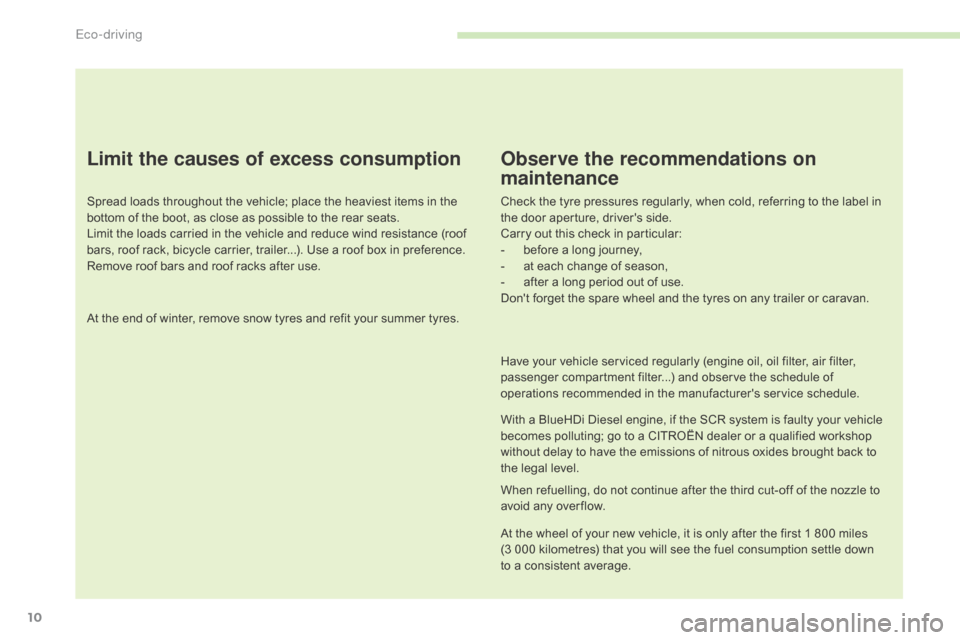
10
Limit the causes of excess consumption
Spread loads throughout the vehicle; place the heaviest items in the bottom of the boot, as close as possible to the rear seats.
Limit
the loads carried in the vehicle and reduce wind resistance (roof
b
ars, roof rack, bicycle carrier, trailer...). Use a roof box in preference.
Remove
roof bars and roof racks after use.
At
the end of winter, remove snow tyres and refit your summer tyres.
Observe the recommendations on
maintenance
Check the tyre pressures regularly, when cold, referring to the label in the door aperture, driver's side.
Carry
out this check in particular:
-
b
efore a long journey,
-
a
t each change of season,
-
a
fter a long period out of use.
Don't
forget the spare wheel and the tyres on any trailer or caravan.
Have
your vehicle serviced regularly (engine oil, oil filter, air filter,
p
assenger compartment filter...) and observe the schedule of
o
perations recommended in the manufacturer's service schedule.
With
a BlueHDi Diesel engine, if the SCR system is faulty your vehicle
b
ecomes polluting; go to a CITROËN dealer or a qualified workshop
w
ithout delay to have the emissions of nitrous oxides brought back to
t
he legal level.
When
refuelling, do not continue after the third cut-off of the nozzle to
a
void any over flow.
At
the wheel of your new vehicle, it is only after the first 1 800 miles
(
3 000 kilometres) that you will see the fuel consumption settle down
t
o a consistent average.
Eco-driving
Page 13 of 428
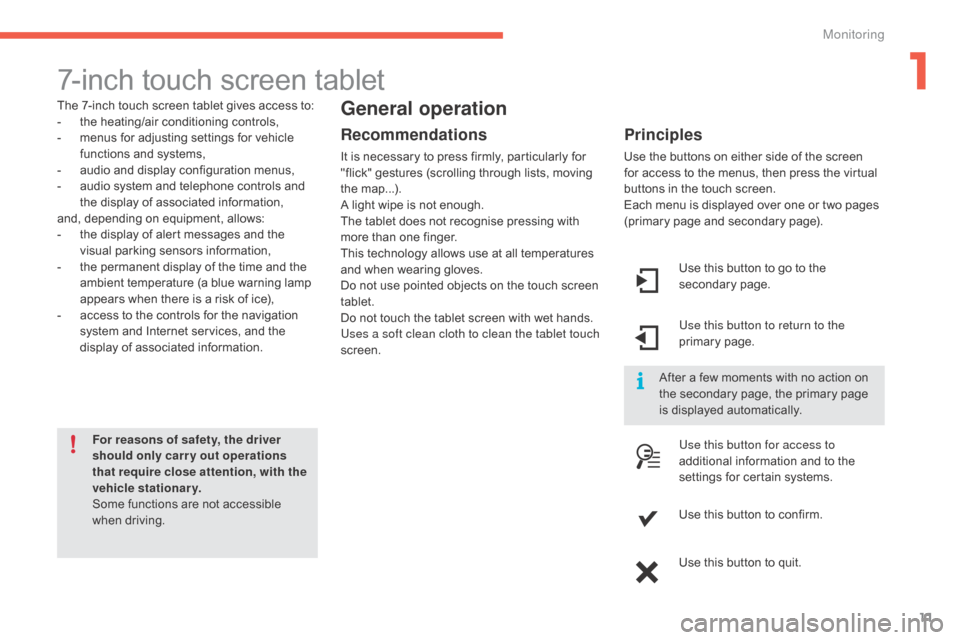
11
7-inch touch screen tablet
The 7-inch touch screen tablet gives access to:
- t he heating/air conditioning controls,
-
m
enus for adjusting settings for vehicle
f
unctions and systems,
-
a
udio and display configuration menus,
-
a
udio system and telephone controls and
t
he display of associated information,
and,
depending on equipment, allows:
-
t
he display of alert messages and the
v
isual
par
king
s
ensors
in
formation,
-
t
he permanent display of the time and the
a
mbient temperature (a blue warning lamp
a
ppears when there is a risk of ice),
-
a
ccess to the controls for the navigation
s
ystem and Internet services, and the
d
isplay of associated information.
For reasons of safety, the driver
should only carr y out operations
that require close attention, with the
vehicle stationary.
Some
functions are not accessible
w
hen
d
riving.General operation
Recommendations
It is necessary to press firmly, particularly for "flick" gestures (scrolling through lists, moving
t
he
m
ap...).
A
light wipe is not enough.
The
tablet does not recognise pressing with
m
ore than one finger.
This
technology allows use at all temperatures
a
nd when wearing gloves.
Do
not use pointed objects on the touch screen
t
ablet.
Do
not touch the tablet screen with wet hands.
Uses a soft clean cloth to clean the tablet touch
screen. Use
this button to go to the
s
econdary
pag
e.
Use this button to return to the
primary
pag
e.
Use this button for access to
additional
information and to the
s
ettings for certain systems.
Use
this button to confirm.
Use
this button to quit.
Principles
Use the buttons on either side of the screen for access to the menus, then press the virtual
b
uttons in the touch screen.
Each
menu is displayed over one or two pages
(
primary page and secondary page).
After
a few moments with no action on
t
he secondary page, the primary page
i
s displayed automatically.
1
Monitoring
Page 14 of 428

12
1. access the the "Air conditioning" menu. A
llows adjustment of the various settings
f
or temperature, air flow... See the sections
o
n "Heating", "Manual air conditioning" and
"
Automatic air conditioning".
2.
a
c
cess to the " Driving assistance "
menu.
A
llows certain functions to be switched on
a
nd off and their settings adjusted.
3.
a
c
cess to the " Media"
menu.
S
ee the Audio and telematics section.
4.
a
c
cess to the " Navigation"*
menu.
S
ee the Audio and telematics section.
Touch screen tablet menus
5. access to the "Configuration" menu. A
llows configuration of the display and the
s
ystem.
6.
a
c
cess to the " Connected services "*
menu.
S
ee the Audio and telematics section.
7.
a
c
cess to the " Telephone"
menu.
S
ee the Audio and telematics section.
*
Depending on equipment.
8.
V
olume / mute.
S
ee the "Audio and telematics" section.
Monitoring
Page 15 of 428

13
State of adjustable systems
Some systems have a dedicated button, to which is associated an indicator lamp.
Illumination
of this lamp indicates whether the
s
ystem is activated or deactivated compared to
t
he default (factory) setting.
Green
indicator: you have switched on the
c
orresponding system.
Orange
indicator: you have switched off the
c
orresponding system. Operating fault
In the event of a fault with one of these
systems,
the indicator lamp in the activation/
deactivation
button flashes for a few moments.
An
alert symbol is displayed to the right of the
b
utton symbol, then, in the case of systems that
a
re activated by default, the orange indicator
c
omes on permanently.
Every
time the button is pressed, the indicator
f
lashes for a few moments.Example:
●
F
unction not activated.
●
O
perating fault alert.
then
"Driving assistance" menu
1
Monitoring
Page 16 of 428

14
The functions accessible in this men are detailed in the tables below.
Bu tton Corresponding function Comments
Speed settings Memorisation
of speeds for use with the speed limiter or cruise control.
Under-inflation initialisation Reinitialisation
of the under-inflation system.
Diagnostic List
of current alerts.
Monitoring
Page 17 of 428
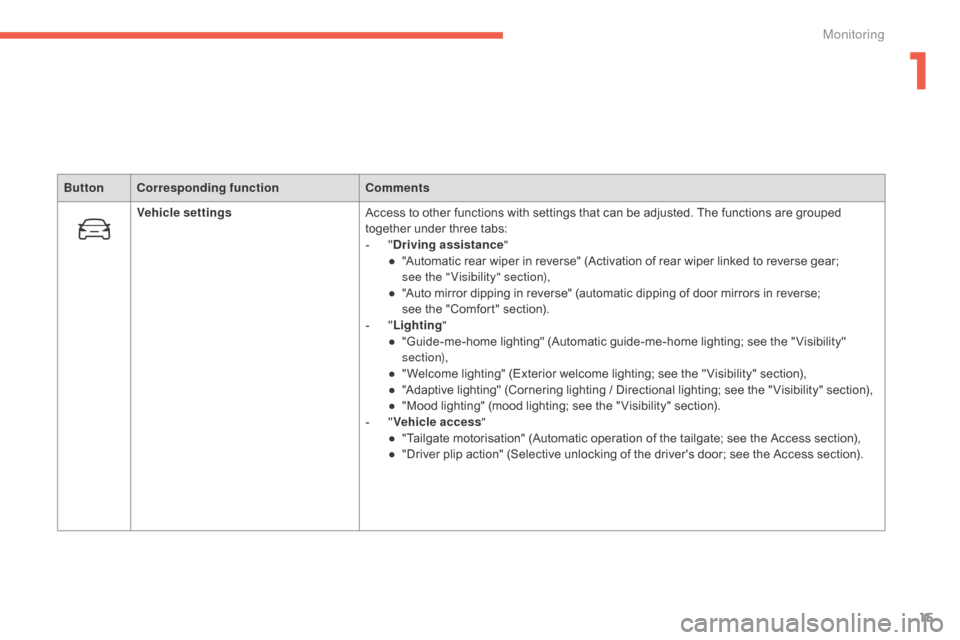
15
ButtonCorresponding function Comments
Vehicle settings Access
to other functions with settings that can be adjusted. The functions are grouped
t
ogether under three tabs:
-
"D
riving assistance"
●
"
Automatic rear wiper in reverse" (Activation of rear wiper linked to reverse gear;
se
e
the "Visibility" section),
●
"
Auto mirror dipping in reverse" (automatic dipping of door mirrors in reverse;
s
ee the "Comfort" section).
-
"L
ighting"
●
"
Guide-me-home lighting" (Automatic guide-me-home lighting; see the " Visibility"
s
ection),
●
"
Welcome lighting" (Exterior welcome lighting; see the " Visibility" section),
●
"
Adaptive lighting" (Cornering lighting / Directional lighting; see the " Visibility" section),
●
"
Mood lighting" (mood lighting; see the " Visibility" section).
-
"V
ehicle access"
●
"
Tailgate motorisation" (Automatic operation of the tailgate; see the Access section),
●
"
Driver plip action" (Selective unlocking of the driver's door; see the Access section).
1
Monitoring
Page 18 of 428
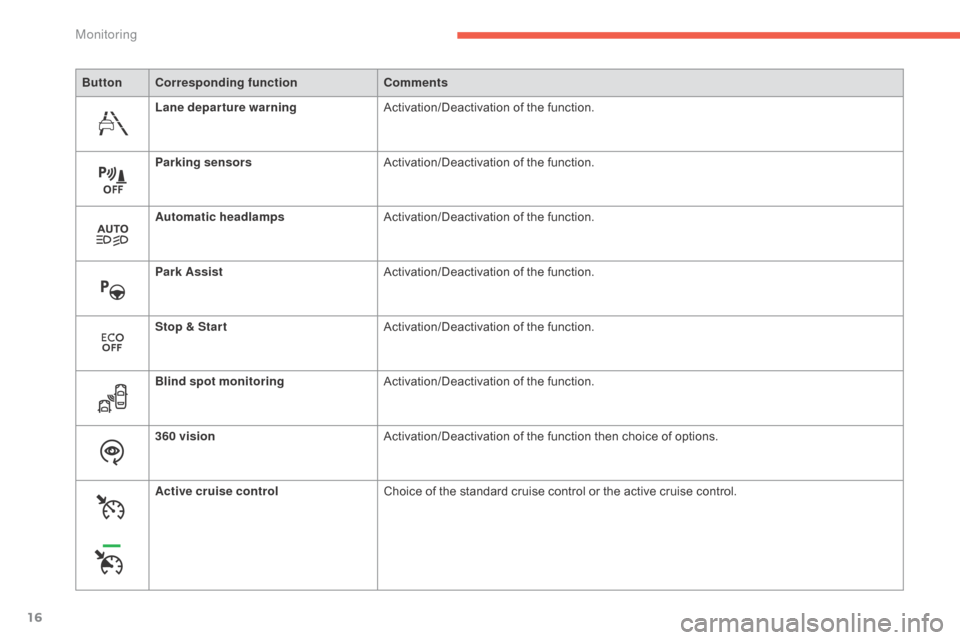
16
ButtonCorresponding function Comments
Lane departure warning Activation/Deactivation
o
f
th
e
f
unction.
Parking sensors Activation/Deactivation
o
f
th
e
f
unction.
Automatic headlamps Activation/Deactivation
o
f
th
e
f
unction.
Park Assist Activation/Deactivation
o
f
th
e
f
unction.
Stop & Star t Activation/Deactivation
o
f
th
e
f
unction.
Blind spot monitoring Activation/Deactivation
o
f
th
e
f
unction.
360 vision Activation/Deactivation
of the function then choice of options.
Active cruise control Choice
of the standard cruise control or the active cruise control.
Monitoring
Page 19 of 428
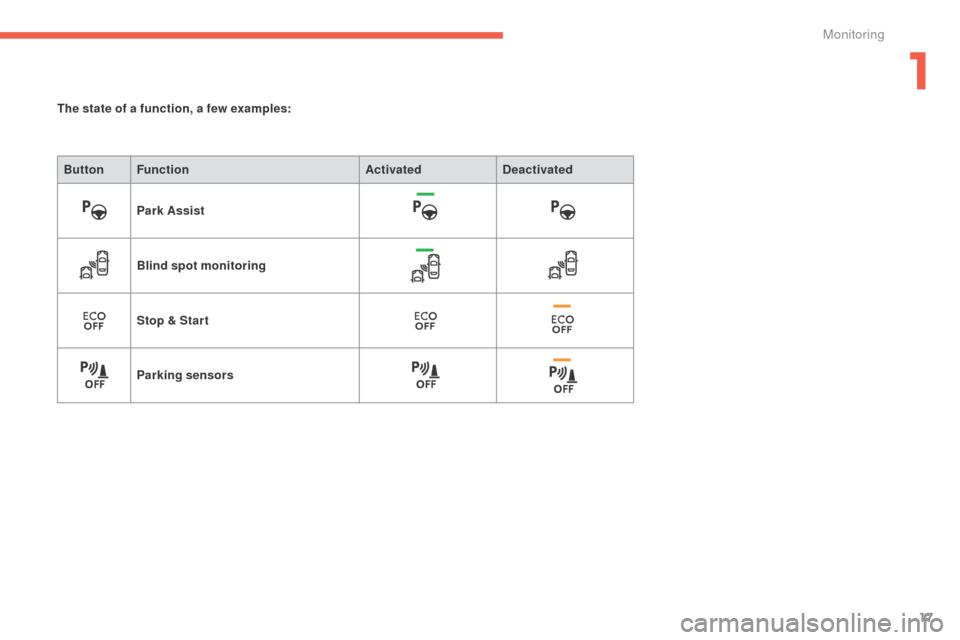
17
The state of a function, a few examples:Button Function ActivatedDeactivated
Park Assist
Blind spot monitoring
Stop & Star t
Parking sensors
1
Monitoring
Page 20 of 428

18
"Configuration" menu
The functions available through this menu are detailed in the table below.
Bu tton Corresponding function Comments
Audio settings Adjustment
of volume, balance...
Colour schemes Choice
of a colour scheme.
Interactive help Simplified
i
nstructions.
Turn off screen Turns
the screen off.
Brightness Adjustment
of brightness.
Monitoring